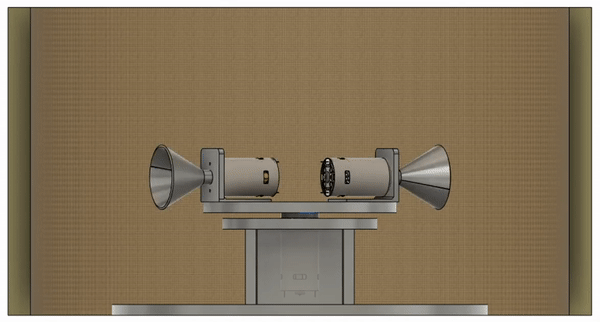2000x Fab Spinning Machines
DIY Filter Media Production on a Global Scale
by Filippos Tourlomousis, Camron Blackburn, Jiri Zemanek, Zach Fredin and
Neil Gershenfeld
The Center for Bits and Atoms, MIT
Problem
shortage of respiratory filter Media
Proposed Solution:
90 countries = 2000x Fab
Labs = 2000x Fab Spinning Machines
Research Question
- rapid prototyping - high throughput - high quality factor - high surface to volume ration (no post porcessing) - control reproducible fiber diameter - porosity We hypothesize that by combining the advantages of cotton-candy inspired rotary jet spinning (RJS) (Parker et al. 2010) and needless electrospinning (Lu et al. 2010)
Fab Spinner Concept
Sketch:
CAD:


Challenges
Filters: Sterility
Ask FDA related to solvents
put image of post-cleaning workflow
Filters: Quality Factor
Testing
Filter Testing Metrics from Camron
Design Requirements
We aim to rapidly fabricate membranous filter media against the COVID-19 virus while minimising breathing resistance in respiratory applications. Our design goals are to maximise COVID-19 filtration efficiency and minimize pressure drop (air flow resistance) across the membrane so that the patient doesn't have to work too hard to breath.
Commercial respiratory filter media that meet regulatory metrics are linked HERE: Commercial Flo-Guard Breathing Filters.
Commerical respiratory filters are made from these materials......
Specific design goals metrics are listed below.... These are based on ....
B. Process: Electrospinning
To adress a possible outage of commercial respiratory filters due ot the CVD pandemic, we propose the design of machines for the production of nonwoven fibrous membranes made from inorgancic polymer composites with the electrospinning process. Electrospun membranes can be employed as antiviral filter respiratory media in protective equipment against the CVD-19 virus. The benefits of electrospun membranes over conventional filter media media are:...... The electrospinning process is simple... The challenge is throughput... but is solvable... explain why...
The electrospinning process is based on the electrohydrodynamics phenomenon, where a material substrate loaded within a syringe with a charged needle tip attached to it and pointing towards a grounded collector, is extruded and subsequenlly stretched using a high volatage potential. Assuming that the material substrate is viscoelastic enoough and as soon as the electrostatic stresses overcome the surface tension of the material, fibers in a chaotic motion are deposited on the collector. The fiber formation mechanism is shown in the video below:
The two main types of electrospinning process are: a) solution electrospinning (SES) and b) melt electrospinning (MES). This classification is based on the material form used for processing; with SES using a polymer solution (pellets/powder mixed with solvent) and MES using pure polymer melt without any chemical solvents. The 3 main common system components for both process types are: a) the extrusion device that can be either mechanical using a syringe pump or pneumatic, b) a high-voltage power supply and c) a collector that in the most basic setup is a flat grounded aluminum plate.
Different types of nozzles and collectors assembled either in a horizontal or vertical configuarations have been reported in the literature leading to different types of electrospinning processes. Each electrospinning process has advantages and disadvantages depending on the application.
C. Which is the most suitable type of electrospinning process for repsiratory folter media production?
ENM can be potentially employed to filter a variety of pollutants. ENM can capture PM due to a combination of small diameter, small pore size and high specific surface area. Moreover, the surface of ENM can be functionalized to adsorb different VOCs. Electrospun nanofibres can also be engineered to reduce the pressure drop which is immensely desirable for respiratory filter media. Carefully engineered ENMs can simultaneously extract harmful aerosols and gases from the air with minimum air resistance. This hypothesis is tested in various experiments involving different approaches, viz. beaded nanofibres, bilayer nanofibres, use of specific additives, and surface modification of electrospun nanofibres. This research is aimed at studying ENM as a protective material against different air pollutants while minimising breathing resistance in respiratory applications with the following objectives: [1] To reduce pressure drop (air resistance) across the ENM while maximising PM filtration efficiency;
- high-throughput
- multiple nozzles
- rolling collector
- polymer solution for functionalization
- hydrophobicity
- anti-viral material
- fast cheap assembly
Below in Section "D" we propose 3 different types of electrospinning machines of varying complexity and capabilities staring from the simplest one that can be made with off-the0shelf components that might be laying around in a hospital, moving to a simple design that reducing the cost, is parallelizable and can be made in a fab lab using a laser cutter and a 3D printer and resulting to a slightly more advanced for increaed throughput.